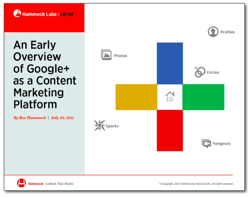 Last July, Hammock Labs issued a brief ebook (we called it an “ebrief”) that reviewed and analyzed Google Plus. We were intrigued enough by Google’s brand new service that we broke our rule of giving a new service and platform a break-in period before suggesting any client use it.
Last July, Hammock Labs issued a brief ebook (we called it an “ebrief”) that reviewed and analyzed Google Plus. We were intrigued enough by Google’s brand new service that we broke our rule of giving a new service and platform a break-in period before suggesting any client use it.
When first launched, Google Plus was not open to company pages, so we suggested individuals log on with their Google accounts and try it out.
Six months later, Google Plus’ public reception is a classic example of a new technology expectation curve called by some, the “hype cycle.” Rex has written about the hype cycle and the idea’s origin in the writings of futurist Paul Saffo. The process goes something like this:
- Introduction
- Over-hype
- Over-expectation
- Disappointment
- Under-expectation
- Long-term adoption leading to a slowly emerging impact that outperforms the initial hype
Unfortunately, some new technology stinks and never makes it onto the curve at all. This curve applies only when looking backward to analyze truly disruptive technology.
That said, it’s important to note that Google Plus is still in a very early phase of development — despite Google’s investment in the service and its evolution since July. We predict one day it will make it through to the end of the hype cycle and become a part of the way we work.
Now that the over-the-top initial enthusiasm is over, Google Plus is evolving at a slower, more realistic pace. The service is one worth trying out as a business promotional tool so that you’ll be there when others realize they have no choice but to play with Google.
What do we mean by that?
Google, with great controversy among some parties, is making Google Plus the dashboard of some of the ways it identifies and presents companies to potential customers. For example, information from Google Plus is being incorporated into search results and to map-oriented services like Google Places. Google sees these actions as key to staying competitive with Facebook — so most of what we wrote back in July still stands.
The jury is still out on Google Plus, but it’s clear that it’s not going away.

